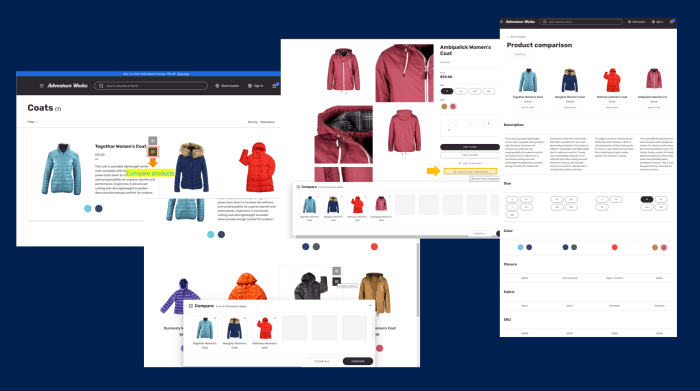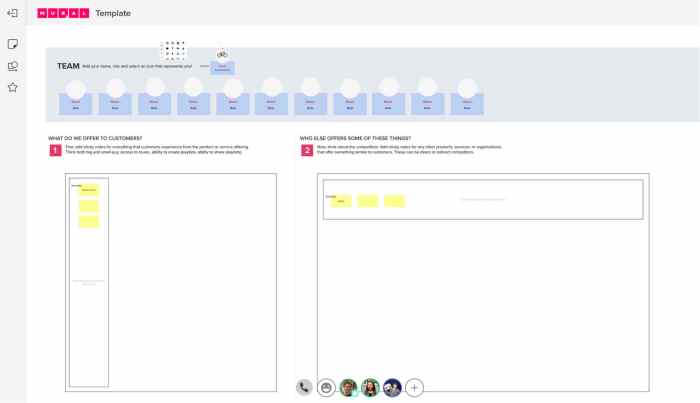Creating Product Comparison Pages sets the stage for this enthralling narrative, offering readers a glimpse into a story that is rich in detail with American high school hip style and brimming with originality from the outset.
Whether you’re a savvy shopper or a curious consumer, diving into the world of product comparison pages opens up a realm of possibilities and insights that can revolutionize your shopping experience. From dissecting the essential elements to navigating design and layout considerations, this guide will equip you with the tools to make informed decisions like a pro.
Introduction to Product Comparison Pages

Product comparison pages are dedicated webpages that allow consumers to compare multiple products side by side. These pages typically display key features, specifications, prices, and customer reviews to help users make informed purchasing decisions.
Creating product comparison pages offers several benefits for consumers. Firstly, it saves time by providing all relevant information in one place, eliminating the need to visit multiple websites or stores. Secondly, it enables shoppers to easily compare different options, leading to confident decision-making. Lastly, it promotes transparency and helps users find the best value for their money.
Popular Websites Utilizing Product Comparison Pages
- Amazon: Amazon’s product comparison feature allows users to compare products based on price, ratings, and specifications, making it easier to find the right product.
- CNET: CNET’s product reviews often include comparison tables that highlight the pros and cons of different products within the same category.
- Consumer Reports: Known for its unbiased reviews, Consumer Reports includes detailed product comparisons to help consumers make well-informed decisions.
Elements of an Effective Product Comparison Page: Creating Product Comparison Pages
When creating a product comparison page, there are several essential elements that you should include to ensure it is informative and helpful for your audience.
Clear Product Information
- Provide detailed and accurate product descriptions for each item being compared.
- Include key features, specifications, and technical details to help users understand the products better.
- Ensure that prices, discounts, and availability are clearly displayed to assist users in making informed decisions.
Product Images and Specifications
- Include high-quality images of each product from multiple angles to give users a visual representation.
- Display product specifications in a clear and organized manner for easy comparison between different items.
- Highlight unique selling points and benefits of each product to help users differentiate between them.
User Reviews and Ratings
- Integrate user reviews and ratings to provide social proof and credibility to the comparison page.
- Allow users to share their experiences and opinions on the products to help others make informed decisions.
- Include a rating system or feedback mechanism for users to express their satisfaction levels with the products.
Design and Layout Considerations

When designing a user-friendly product comparison page, it is essential to consider the layout and organization of the information. A well-designed comparison page can help users make informed decisions quickly and easily. Here are some best practices to follow:
Organizing Products
- Group products by category or type to help users easily find what they are looking for.
- Use clear and concise product names and descriptions to avoid confusion.
- Include relevant specifications and features for each product to provide a comprehensive overview.
- Consider using filters or sorting options to allow users to customize their comparison experience.
Layout Options
- Side-by-Side Comparisons: Display products next to each other for easy comparison of features and specifications.
- Interactive Tables: Use interactive tables that allow users to sort, filter, and compare products based on their preferences.
- Grid Layout: Organize products in a grid format with clear visuals and concise information for a visually appealing comparison page.
- Vertical List: Present products in a vertical list format with bullet points for a simple and straightforward comparison.
Tools and Plugins for Creating Product Comparison Pages
Creating product comparison pages can be made easier and more efficient with the help of various tools and plugins available in the market. These tools offer different features and functionalities that cater to the specific needs of comparing products in a clear and organized manner.
Popular Tools and Plugins
When it comes to creating product comparison pages, several popular tools and plugins stand out for their user-friendly interfaces and customizable options. Some of the top tools include:
- WordPress Comparison Plugin: This plugin is perfect for those who have a WordPress website and want to easily create product comparison tables. It allows for easy customization and integration with different themes.
- TablePress: TablePress is another popular plugin that lets you create responsive tables for product comparisons. It offers a wide range of customization options and is easy to use even for beginners.
- WooCommerce Product Table: For those running an online store with WooCommerce, this plugin is a great choice. It allows you to display products in a table format for easy comparison by customers.
Comparison of Features and Functionalities
Each tool and plugin mentioned above has its own set of features and functionalities that make them unique. While the WordPress Comparison Plugin is ideal for WordPress users, TablePress offers more flexibility in terms of design and customization. On the other hand, WooCommerce Product Table is specifically designed for online stores looking to enhance the shopping experience for customers.
Recommendations, Creating Product Comparison Pages
The choice of tool or plugin for creating product comparison pages ultimately depends on the type of products being compared and the specific requirements of the website. For informational websites, the WordPress Comparison Plugin may be the most suitable option, while e-commerce sites may benefit more from using WooCommerce Product Table. It’s essential to assess the needs of the website and the target audience before selecting the right tool for the job.